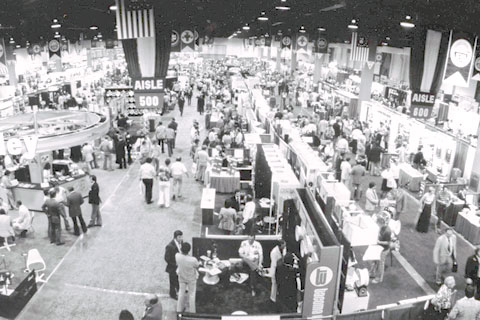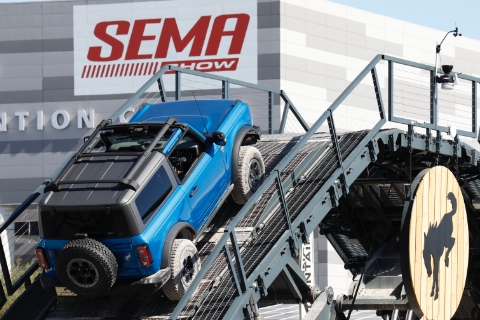SEMA News—February 2011
Market Trends in Tires and Wheels
 Prominent trends within the tire segment include the development of low-rolling-resistance “eco” tires as well as the continuing popularity of ultra-high-performance models. |
|
“Several tire companies have described to me that they cut down production in mid- to late-2009 to adjust expenses for the poor economy and the expectation of lower tire sales,” said David Freiburger, editor-in-chief of Hot Rod magazine. “However, demand rose by the third quarter of 2010. As tires wore out, people had no choice but to replace them. Demand was on the upswing, but warehouses were short on stock as a result of cutbacks, and a few manufacturers are scrambling to fill orders and are short on some sizes. The urgency to fill orders may delay a couple of new tire launches.”
The startling upsurge also put several companies in an all-hands-on-deck posture to keep up with the market.
“Two or three of the companies that we have talked to have been running their plants 24 hours a day, seven days a week,” said Bruce Davis, special projects reporter for Tire Business, a trade newspaper. “Their inventories are still relatively lean because they took out a lot of capacity, so they can sell every tire they make.”
The Rubber Manufacturers Association (RMA) reported in the past few weeks that tire shipments in the industry were expected to have grown 9% in 2010 versus 2009, according to David Zielasko, the editor and vice president/publisher of Tire Business. But the RMA also said that it is not as optimistic about 2011, predicting that growth would plateau at about 2%–3% growth. Retailers can also expect that tire prices will continue to increase.
|
SEMA News Sponsor |
 |
Partly as a result of those market forces, the importation of tires continues to grow, even with the tariffs that have been placed on Chinese-made light-truck tires that were imported into the United States. Retailers are looking to suppliers in India, Thailand and other offshore sources to help stem the tide of demand until the domestic manufacturers are able to fully fill the void.
 “As niche tire makers wish to expand into the musclecar marketplace, they need to consider some 18-in.-wheel tire sizes that are taller than what’s commonly available in ultra-high-performance tread patterns,” said David Freiburger, editor-in-chief of Hot Rod. |
|
“The all-season UHP tire segment is hot right now,” he said. “Drivers want to use their vehicles throughout the year, and many sports cars come with summer designs. While not winter tires, all-season UHPs offer enough traction and reliability to allow drivers to keep their vehicles out longer.”
Freiburger said that the popularity of ultra-high-performance tires and mostly 18-in.-diameter wheels may have also been fueled by the continuing Pro Touring trend of handling-related musclecars in the enthusiast market. Many show vehicles continue to be shod with 20- and 22-in. wheels and tires, but he believes that the market may now be shifting to more usable sizes because of the economy.
“The trend to larger-diameter wheels is so common that it’s becoming difficult to find 15-in. general-performance street tires outside of Mickey Thompson, Coker Tire and a few others,” he said. “As niche tire makers wish to expand into the musclecar marketplace, they need to consider some 18-in.-wheel tire sizes that are taller than what’s commonly available in ultra-high-performance tread patterns.”Many manufacturers are also putting significant effort into dedicated winter tires, according to the Tire Business editorial team. They pointed out that winter tires use specific rubber compounds that retain their grip and pliability even when temperatures dip below 45ºF, which is where all-season tires tend to suffer.
|
SEMA News Sponsor |
 |
“As tires wear out, fine rubber particles remain on the road and end up going into the ground through the drainage system,” he said. “These fine particles contain ‘dirty oils’ regarded as harmful and carcinogenic. New ‘clean oils’ reduce the harmful deposits of aromatic oils from worn tires, but you don’t just change a couple of things in a rubber compound and expect it to provide the same performance capabilities, traction, wear rating and so forth. That requires an element of research and development that is fairly expensive, but tire companies have been very successful in the development of green compounds that literally do not contain carcinogenic oils.”
 Wheel configurator webpages have become commonplace, allowing a customer to select a particular wheel, place it virtually on a specific vehicle make and model and even change both wheel and vehicle colors to help in the selection process. |
|
“The chemistry reduces the hysteresis of rubber, which is its propensity to generate heat,” said Tire Business’ Davis. “If you can keep the rubber from generating heat, the tire rolls more freely and with less resistance. The manufacturers combine that with tweaks in the tread and casing design and fine-tuning the components to reduce the weight of the tire, and they wind up with a tire with reduced rolling resistance and improve fuel mileage for the vehicle.”
Davis and Zielasko said that the manufacturers are currently pricing these “eco tires” at a premium, but they are not sure whether the marketplace will embrace the new technology at the higher costs. Still, as the government mandates greater fuel economy for future vehicles, lower-rolling-resistance tires are bound to become more common.
“Another interesting component of this is that the federal government is looking to come out with new fuel-efficiency ratings and tire labels for consumers through the National Highway Traffic Safety Administration (NHTSA),” Zielasko said. “The NHTSA is looking at three different components. When a consumer goes in to buy a tire, he would be able to see how it performs in terms of rolling resistance, its traction rating and its durability or tread wear.”
While such labeling may be on the horizon, vehicle owners are more frequently than ever before, seeking tire information and advice from Internet forums that are tailored to specific types of vehicles. Dealers need to ensure that they also have an Internet presence for those consumers who want to research tires online.
“We have a program called Buy Now, which directs end users to one of our retailers to buy the product in virtually two clicks,” said Robinson. “They buy direct from our dealer network at very competitive prices.”
The Internet has also come to play a substantial role in wheel marketing. Consumers use the web as a research tool, shopping for the look and size they want and then visiting retail sites to find the best pricing available. Wheel configurator pages have become commonplace, allowing a customer to select a particular wheel, place it virtually on a specific vehicle make and model and even change both wheel and vehicle colors to help in the selection process. Consumers also visit online forums to take part in discussions about wheel choices, and Brock Weld, president of BMF Wheels Inc., said that even retailers he knows visit the forums to collect installation tips and tricks as well as to promote their businesses.
|
|
|
Economic uncertainty has led wheel companies both large and small to postpone major investments, so the development of new products has given way to makeover strategies in which basic designs remain unchanged but cosmetic enhancements help to maintain a sales plateau. Even so, there are signs of a thaw and a gathering stream of optimism.
“The greatest opportunities lie in niche branding and niche markets, figuring out for each wheel company not only what they’re good at, but making sure they’re the best,” said Weld. “Cash is king right now. Retailers don’t want to put anything on the floor that might not move, so people are trying to make money with what they already have both on the manufacturing side and on the retail side.”
Fenton Liffick, president and CEO of Prestige Autotech Corp., said that he’s seeing more sculptured spokes, patterned inlays and multicolor construction, and Freiburger said that large-diameter wheel designs inspired by traditional styles have come into vogue.
“Kidney-bean and five-spoke models have been commonplace for many years,” Freiburger said, “but now we’re seeing even more interest in slot mags, especially Gasser style, and in wheels that mimic the Minilites for Pro Touring cars.”
In the truck market, 8-Lug HD Truck magazine editor Bob Carpenter and contributing editor Joe Burnside said that black and chrome comprise the most popular offerings they see, but Liffick and Weld said that wheel designers are also working frequently with new finishes and coatings. A glance through the new-wheel offerings from the SEMA Show (see p. 22) seems to bear them out.
“Black wheels have been all the rage for a few years, but now everybody is experimenting with different kinds of blacks,” Weld said. “Changing the finishes on the wheel is something that retailers and consumers alike are focusing on, so people have been trying to put multiple colors on wheels. The three-piece manufacturers have been doing it for quite a while. But modular three-piece wheels are usually forged or a combination of a forged center and a cast rim. The market has been going away from forged except for the most exclusive wheel lines because of price. Forging is an expensive process, and it only works when you’re doing thousands of the same forging.”
Weld and other manufacturers believe that the broader wheel market is on the road to recovery and that there is still room to grow, especially internationally.
“Even some of the retailers we supply are selling to the international markets because the dollar is making it favorable to do so,” he said. “There are a lot of people who are capitalizing on business even in China, where the domestic market is actually booming in wheel sales right now.”
Kelly Austin, director of sales for Ultra Wheel Co., reiterated that retailers should take advantage of the niche opportunities in the market. “There are new wheel niches popping up every day,” he said. “Find the ones that fit your core business and go after them vigorously. Niches create excitement and offer better profit margins because of exclusivity. Retailers who listen to their customers’ wants and needs are succeeding very well, but also take the time to refresh or retrain your staff to be more knowledgeable and courteous. Then, when opportunities come, be prepared with products on hand to close the sale.”




